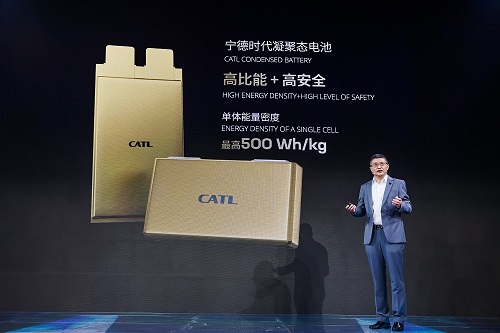 |
Welcome To Evlithium Best Store For Lithium Iron Phosphate (LiFePO4) Battery |
 |
Recently, CATL (Contemporary Amperex Technology Co. Limited) announced a new battery technology called condenset batteries, focusing on high specific energy and high safety, with a single cell energy density of up to 500Wh/kg.
According to CATL, in response to the electrochemical reactions of high-specific-energy chemical materials, solid-state batteries utilize high-power biomimetic solid-state electrolytes, which can form a micro-level adaptive network structure. This enhances the stability of the microstructure while improving the battery's dynamic performance.
It is worth noting that amidst the repeated delays of solid-state batteries and semi-solid-state batteries, during the press conference, CATL's Chief Technical Officer, Wu Kai, stated that CATL aims to achieve mass production of solid-state automotive batteries by the end of this year. They have also collaborated with civilian aircraft companies for electric motor development.

According to a research report by CICC (China International Capital Corporation), it is expected that several car brands will lead the way in mass-producing semi-solid-state batteries this year. They suggest paying attention to investment opportunities in the solid-state battery industry chain, from the initial stage to the first step.
So, what exactly are solid-state batteries? And what advantages do they have compared to traditional lithium-ion batteries?
The solid-state battery industry is currently in its early stages.
Solid-state batteries refer to lithium-ion batteries that use solid-state electrolytes.
Solid-state batteries are a type of battery technology that differs from the commonly used lithium-ion batteries and lithium-ion polymer batteries. They use solid electrodes and solid electrolytes.
As the scientific community believes that lithium-ion batteries have reached their limits, solid-state batteries have been considered as a potential successor to lithium-ion batteries. Solid-state lithium batteries employ glassy compounds made of lithium and sodium as conductive materials, replacing the electrolyte used in conventional lithium batteries and significantly increasing their energy density.
The major difference between solid-state batteries and the mainstream lithium-ion batteries lies in the electrolyte. Solid-state batteries use solid electrolytes, replacing the liquid electrolyte and separator used in traditional lithium-ion batteries. Traditional lithium-ion batteries consist mainly of positive and negative electrode materials, electrolytes, and separators. The electrode materials determine the battery's capacity, while the electrolyte and separator act as the medium for lithium-ion transport. This is the fundamental distinction.
Solid-state batteries can achieve a balance between high safety and high specific capacity, and in the long term, they can achieve lower manufacturing costs compared to liquid-state batteries. Solid-state batteries can simultaneously achieve high safety and high specific capacity electrode materials, which are essential for achieving higher energy density. Additionally, due to higher theoretical module space utilization and simplified battery assembly processes, solid-state batteries have lower theoretical costs than liquid-state batteries.
In terms of safety, solid-state electrolyte materials exhibit good thermal stability and are less prone to combustion. Solid-state batteries also eliminate the risk of electrolyte leakage, resulting in better safety performance.
In terms of energy density, solid-state batteries have good compatibility with lithium metal anodes, high module space utilization, and flexible configurations, which are expected to further improve energy density.
Although solid-state batteries have many advantages, they face numerous challenges on the road to application and still need to address several key issues.
The first challenge is supply chain reconstruction: Solid-state batteries bring significant changes compared to the mature liquid-state lithium battery technology. Therefore, the already complex lithium battery supply chain needs to be reconstructed, which is a daunting task.
The second challenge is cost reduction: The production cost of new technology materials used in solid-state batteries, such as pre-lithiated silicon-carbon anodes or prospective lithium metal anodes, high-nickel cathodes, and solid-state electrolytes, is much higher than the corresponding materials currently used. Thus, the path to cost reduction is extremely challenging and lengthy.
The third challenge is poor fast-charging efficiency. The ionic conductivity of solid-state electrolytes is only about one-tenth of that of liquid electrolytes. This leads to poor fast-charging efficiency, which significantly affects practical applications.
Edit by editor
All Rights reserved © 2025 Evlithium Limited